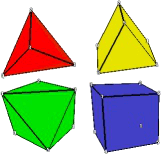
From September 2003 to August 2004, I was involved in research on subdivision algorithms at the computer science department of Rice University in Houston/USA. My thesis is on how to combine uniform volumetric subdivision schemes of cubes, triangular prisms, tetrahedra, and octahedra into a single volumetric scheme.
I derive an algorithm for mixed, unstructured volume meshes consisting of these four types of shapes. In the limit, the scheme yields a parametrization of space that is
During the two semesters, Scott Schaefer helped me on issues of programming and subdivision. My advisor was Joe Warren.
| Smooth Subdivision for Mixed Volumetric Meshes (Thesis) |
|
3 MB |
| Subdivision and deformation tool (including C++ source) * |
|
200 kB |
Für das Können gibt es nur einen Beweis: das Tun.
Marie von Ebner-Eschenbach
Subdivision of a volume mesh is very similar to subdivision for surfaces. Iteratively, shapes are split into smaller shapes and vertices are positioned according to certain mathematical formulas to make the outcome appear as smooth as possible. Volumetric subdivision induces a C2 parametrization of space almost everywhere.
Publications related to my thesis are
The thesis is referenced in
Spinnweben: das Fliegengitter des kleinen Mannes.
Thomas Tonn
Besides contextualized space partitioning, the major motivation for volumetric subdivision is to perform smooth deformations of surface models.
The deformation procedure requires the following input:
Let
 be the
be the
 matrix consisting of the
matrix consisting of the
 vertices of the surface model mesh, that is
vertices of the surface model mesh, that is

And let
 be the
be the
 matrix consisting of the
matrix consisting of the
 vertices of the volumetric control mesh.
We are interested in a matrix
vertices of the volumetric control mesh.
We are interested in a matrix
 that satisfies
that satisfies

We deform the surface model by changing the vertices of the control mesh to
 .
Then, the vertices of the deformed surface model compute as
.
Then, the vertices of the deformed surface model compute as

My thesis describes how to obtain
 as a matrix product, where
as a matrix product, where

Given the initial meshes, the
software
that we provide outputs the matrix
 .
.
To demonstrate the quality of this approach, we deform the model Noma into several poses by designing and altering a volumetric control mesh:
Credits:
The subdivision algorithm and the deformation results were presented within the scope of the mathematical "Studentische Vortragsreihe 2005" as well as on the 2005 "Workshop" of the geometric modeling research group of the Technische Universität Darmstadt/Germany.
Per aspera ad astra
[translation]